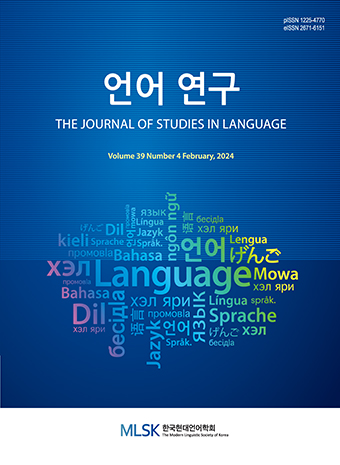Research Article
Abstract
References
Information
This study examines the spectral characteristics of English voiceless fricatives depending on the manner and place of articulation, gender, age, the post-fricative vowel height, and the location in a word based on the Buckeye Corpus of Spontaneous American English Speech. The acoustic analysis results indicate that fricative duration, the center of gravity (COG), variance and skewness play a role in distinguishing all English voiceless fricative articulation places, despite variation in gender, age, the location in a word and the post-fricative vowel height. These acoustic parameters distinguished the sibilant /s, ʃ/ from the non-sibilant fricatives /f, Ɵ/, and alveolar /s/ from palate-alveolar /ʃ/, labiodental /f/ from interdental /Ɵ/: fricative duration, COG, and variance of the sibilant fricatives were significantly longer/higher than those of the non-sibilant fricatives. Skewness was high for the non-sibilant fricatives and low for the sibilants.
- Behrens, S. J. and S. E. Blumstein. 1988. Acoustic Characteristics of English Voiceless Fricatives: A Descriptive Analysis. Journal of Phonetics 16.3, 295-298.10.1016/S0095-4470(19)30504-2
- Forrest, K., G. Weismer, P. Milenkovic, and R. Dougall. 1988. Statistical Analysis of Word-initial Voiceless Obstruents: Preliminary Data. Journal of the Acoustical Society of America 84.1, 115-123. 10.1121/1.396977 3411039
- Fox, R. A. and S. L. Nissen. 2005. Sex-related Acoustic Changes in Voiceless English Fricatives. Journal of Speech, Language, and Hearing Research 48.4, 753-765. 10.1044/1092-4388(2005/052)
- Gordon, M., P. Barthmaier, and K. Sands. 2002. A Cross-linguistic Acoustic Study of Voiceless Fricatives. Journal of the International Phonetic Association 32.2, 141-174. 10.1017/S0025100302001020
- Jongman, A., R. Wayland, and S. Wong. 2000. Acoustic Characteristics of English Fricatives. Journal of the Acoustical Society of America 108.3, 1252-1725. 10.1121/1.1288413 11008825
- Ladefoged, P. 1982. A Course in Phonetics. New York: Harcourt Brace Jovanovich.
- Leech, G., P. Rayson, and A. Wilson. 2001. Word Frequencies in Written and Spoken English: Based on the British National Corpus. Harlow: Longman.
- McMurray, B. and A. Jongman. 2011. What Information is Necessary for Speech Categorization? Harnessing Variability in the Speech Signal by Integrating Cues Relative to Expectations. Psychological Review 118.2, 219-246. 10.1037/a0022325 21417542 PMC3523696
- Nirgianaki, E., A. Chaida, and M. Fourakis. 2009. Temporal Characteristics of Greek Fricatives. Papers of the 9th International Conference of Greek Linguistic, 25-33.
- Nissen, S. L. and R. A. Fox. 2005. Acoustic and Spectral Characteristics of Young Children’s Fricative Productions: A Developmental Perspective. Journal of Acoustical Society of America 118.4, 2570-2578.10.1121/1.2010407 16266177
- Patterson, D. and M. Connine. 2001. Variant Frequency in American English Flap Production: A Corpus Analysis of Variant Frequency in Flap Production. Phonetica 58.4, 254-275.10.1159/000046178 11641632
- Pitt, M. A., L. Dilley, K. Johnson, S. Kiesling, W. Raymond, E. Hume, and E. Fosler-Lussier. 2007. Buckeye Corpus of Conversational Speech (2nd release), Columbus, OH: Department of Psychology, Ohio State University. http://www.buckeyecorpus.osu.edu.
- Shadle, C. H. 1990. Articulatory-acoustic Relationships in Fricative Consonants. In Hardcastle, W. J. and A. Marchal (eds.), Speech Production and Speech Modeling. Dordrecht: Kluwer. 187-209.10.1007/978-94-009-2037-8_8
- Publisher :The Modern Linguistic Society of Korea
- Publisher(Ko) :한국현대언어학회
- Journal Title :The Journal of Studies in Language
- Journal Title(Ko) :언어연구
- Volume : 37
- No :1
- Pages :7-19
- DOI :https://doi.org/10.18627/jslg.37.1.202105.7




 The Journal of Studies in Language
The Journal of Studies in Language






